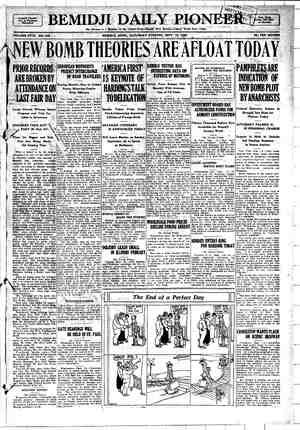The Seattle Star Newspaper, September 18, 1920, Page 7
You have reached the hourly page view limit. Unlock higher limit to our entire archive!
Subscribers enjoy higher page view limit, downloads, and exclusive features.
TO THE EMPLOYES OF THE SEATTLE STAR THE LUMBER INDUSTRY A community is prosperous in propor- tion as its payroll-producing interests prosper. In Oregon and Washington lumber pays approximately 60 per cent of all wages. It employs more than 100,000 people. Payrolls cannot be financed unless products are sold. Products cannot be sold unless markets are available. A serious situation now confronts the — Pacific Northwest lumber industry. It necessarily will reflect in the economic welfare and development of every city or smaller community from California to and beyond the British Columbia line. No extended statement as to the nec- essity of safeguarding the present or future development and growth of the Pacific Northwest lumber industry seems necessary. The problem most serious at this time is the INCREASE IN FREIGHT RATES dating from August 26. In this statement, and in subsequent statements, the lumber industry will deal with this freight rate problem, but not with intent to criticize agencies of transportation,, governmental bodies which fix rates, or competing lumber producers. The industry will attempt to portray conditions as they exist — forecasting slightly as to the future —and ‘in any event furnishing the public an accurate basis from which to reach conclusions as to what the lumber industry needs and must have to exist, as wellas enab- ling the public to realize the conse- quences of failure on the part of all interested to bring about better indus- trial and marketing conditions. The principal product of Pacific North- west lumbering is Douglas Fir. Its principal competitor is Southern Pine. The production of Southern Pine is twice that of Douglas Fir. Statement No. 1—September 18, 1920 For many years to come the produc- tion of Southern Pine will be billions of feet annually in excess of Douglas Fir. The Southern Pine belt is far frqm exhausted. The two woods are sold in the same markets east of Denver; and neither the Fir nor the Southern Pine industry can exist if denied access to markets such as Chicago and other principal lumber- consuming centers. As to logging, manufacturing and the various processes necessary to the placing of the manufactured product on the cars, the two woods may be considered to be substantially on the same basis of cost. But by far the greatest cost in the pro- duction of lumber is labor. It is 60 per cent of the total cost of manufacturing. The South has a low wage scale and a ten- to twelve-hour standard day as against a high wage scale and an eight-hour stand- ard day for Oregon and Washington lum- ber manufacture. And fir is approximately twice as far as Southern pine from the large consum- ing lumber markets. That fact should be remembered, as it is the West Coast’s distance from necessary markets, and the cost of transportation thereto, that has been the West:Coast mill operator’s great obstacle in the past. The recent increase in freight rates has, in effect, removed West Coast mills still farther from the necessary Eastern mar- kets; and this primary problem—trans- portation and the cost thereof—has now become greatly emphasized. For years West Coast manufacturers have struggled to overcome this distance- from-market handicap, without much success until the war created an opportu- nity for wider distribution of West Coast lumber, and caused the West Coast woods to become well and favorably known ina considerable portion of the Fastern part of the United States. AND TO THE PUBLIC: Before the recent advance the North- west Coast rate to Chicago, which is the largest lumber consuming market in the , world, was 60c per hundred pounds; yel- low pine rate was 31 1-2c.. An increase of 331-3 per cent has been added to both rates, thus increasing THE FIR RATE 20c as compared WITH INCREASE FOR SOUTHERN PINE OF 10 1-2c. Before the percentage increase, fir was fighting for its share of the business in Chicago—for instance—under a freight rate handicap amounting to $6.81 per thousand feet of lumber. The present increase adds $2.27 per thousand to that disadvantage, making a total of $9.08 per thousand which FIR WILL HAVE TO ABSORB IN ORDER TO MEET SOUTH- ERN PINE competition at that point. Under the new freight rates fir, in com- petition with Southern pine, is asked to absorb: --8 3.76 per M. ft. or $ 94.00 per average car eo. 9.60 per M. ft. or 240.00 per average car 11.68 per M. ft.or 292.00 per average car - 837 perM. ft.or 209.25 per average car «- 12.46 per M. ft.or 311.50 per average car 11.28 per M. ft.or 282.00 per average car soos 12.12 per M. ft.or 303.00 per average car New York... 13.11 perM. ft.or 327.75 per average car” These are heavy consuming points of both fir and pine lumber. The approximately two hundred thou- sand cars of Northwest forest products shipped annually have heretofore paid a freight bill of FIFTY-FIVE MILLION DOLLARS. If the present increases stand, there will be an added freight charge of FIFTEEN MILLION DOLLARS, pro- vided the same amount of lumber is shipped. This proviso is all important to the rail- roads as well as to the shippers. If we may be allowed to make a-forecast, will state that at present freight rates lumber will not move in the same quantities that it has in the past. West Coast Lumbermen’s Association






